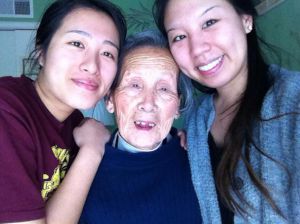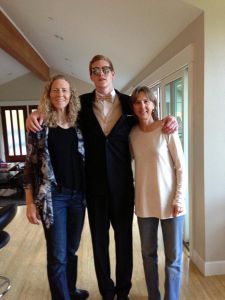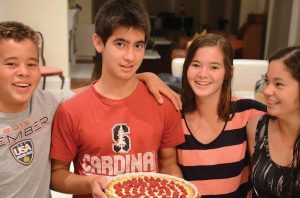The traditional American family, such as families portrayed in 1950s sitcoms such as Leave it to Beaver, is becoming an outdated concept. More recent shows like ABC’s Modern Family portray the transformation of the “typical” American family into a more unconventional, diverse amalgam of cultures and ethnicities.
A 2010 Pew Research Center study done in association with TIME Magazine called this change a “quiet revolution,” going on to state that some researchers believe that the structure of the American family has, in the past five decades, “changed as rapidly as at any time in human history.”
Among the key findings of the survey was the dramatic change in the institution of marriage over time, which the survey stated as one of the main catalysts for the dramatic change in family life. In 1960, 72 percent of American adults were married—comparatively, only 52 percent of Americans were married in 2008.
Because of this rapid change in the institution of marriage, Americans’ views on what constitutes a family have changed dramatically. In 1960, 72 percent of American adults were married—comparatively, only 52 percent of Americans were married in 2008. More survey respondents have agreed that other types of living arrangements constitute as a family—86 percent believed a single parent raising a child was a family, 80 percent believed an unmarried couple raising a child was a family, and 63 percent said a gay or lesbian couple raising a child was a family.
Although these trends are nationwide, this dramatic shift in family life can be seen in the seemingly atypical families of some Redwood students. In order to explore the differences between the stereotypical family and a non-traditional family, The Bark looked into several types of non-stereotypical families of Redwood students: multigenerational, same-sex, and biracial.
Multigenerational
When senior Nancy Luo’s parents emigrated from China in the 1990s, they also came with Luo’s grandmother, who has lived with them ever since.
“I’m a first generation American,” Luo said. “My parents came here about 20 years ago. My grandma came with them, and she lives with us. My grandma used to take care of me because my mom used to work, and it was really hard for her because she didn’t speak English at the time,” Luo said.
According to the 2010 U.S. Census, there are 4.3 million multigenerational households in the U.S., which account for 5.6 percent of family households in the country. This compares to about 8.2 percent in California.
Luo said that as both she and her grandmother have aged, their roles in the house have changed. Her grandmother is currently 93 years old—“old as the wheel,” according to Luo.
“I’m older now, and in that way we’ve sort of changed the caretaker and caregiver roles, so I’m the one taking care of her now. I go home and I make sure that she’s okay and make food for her and stuff,” Luo said.

The relationship between Luo and her grandmother is closely tied to their culture, as well as to personal expectations.
“Because we’re Chinese, we have a lot of duty—like, it’s my duty to take care of my parents when they’re older and make sure they’re okay, and my grandma’s okay.”
Luo also has an older brother and sister, who are currently on the East Coast and in China, respectively.
Less than 3.3 percent of family households in Marin County are multigenerational, according to the 2010 Census.
Luo’s family is part of the 42.2 percent of California’s multigenerational households in which the homeowner lives with a parent and child. The breakdown reveals that 55.7 percent of multigenerational households consist of the homeowner living with a child and grandchild, according to the 2010 Census.
Because of Luo’s family background, her views on changing family life reflect a liberal definition of family. “We’re moving towards a trend where we’re not trying so hard to define things like your family roles,” Luo said.
Luo said that while she has grown up with her grandmother, their relationship does not come without frustration.
“Sometimes I get irritated at the fact I have responsibilities like that, even though I am a senior that I have to take care of my grandma,” Luo said. “That irritation seems to get in the way of how much I love her sometimes. It hurts when I forget later on, because I regret how I feel or think.”
According to Luo, although her grandmother has what she calls “a bit” of Alzheimer’s, she still tries to take care of the granddaughter that she helped raise.
“I’ll come home from school and she’ll ask four or five times if I’ve eaten. Ten times every hour she’ll ask if I’ve eaten,” Luo said.
Same-Sex
According to the 2010 Census, 115,064 same-sex couple households in the United States have children.
Junior Elliot Dean comes from one such household. Dean lives with his two moms, Peg and April, as well as his 13-year-old brother.
“If someone else lived my life they might see it a little different because there’s no dad around, but there’s still two people around that are my parents, and they care for me and they’re always around to pick me up or make dinner,” Dean said. “It’s just that there’s two females instead of a male and a female. Aside from that, I don’t think there’s anything that’s different. It’s just physically who it is is different.”
Dean doesn’t believe that being raised by two mothers instead of a mom and dad has dramatically affected his life.
“Sometimes I wonder what I’d be like if I had a dad, but it’s not too much of a problem because there are other male adults that I can look up to, like coaches or teachers or family friends,” Dean said.

Female-female couple households are almost twice as likely to have children as male-male couple households. 10.5 percent of male-male couple households have children, whereas the percent of children in female-female households is significantly higher at 21.6 percent.
Dean believes that family constitutes a parent and a child, no matter the gender of the parents. “I think when you’re talking about a family you’re talking about parents and kids, or parent and kid, but I think family encompasses the whole combination of a parent and a kid, at least one,” said Dean. “There’s got to be a lot of love there, and that bond between children and their parents. I don’t think who’s in it matters, I think the relationship and how strong the relationship is matters.”
Biracial
“Having a biracial family opens the children’s eyes more to the diversity of the world, and it keeps me open towards other cultures,” said sophomore Camille Kawawa-Beaudan, whose family is of mixed race. “Raising a family whether you’re biracial or not is hard, but there’s no additional challenge.”
Camille and her younger brother, freshman Maxime, hail from a biracial, bicultural family that is half-French, half-Japanese. According to the U.S. Census, about five percent of California residents indicated that they were two or more races, and although this figure seems small, the national population of those who identify with more than one race grew by 34 percent.
These numbers mark a significant increase in interracial couples in the past four decades—according to the Pew Research Center, in 1960, only two percent of newly married couples were biracial, compared to 15 percent in 2008.
At Redwood, the percentage of those who identify with two or more races is much higher, at 7.8 percent of the student body’s population of 1,535, according to the state mandated 2012-13 School Accountability Report.
For the Kawawa-Beaudans, however, it is not their race that makes their family values unique, it is their French and Japanese heritage.
“Our family didn’t really assimilate into this culture very much,” Maxime said. “We still hold a lot of our values from our French and Japanese sides, and the American culture kind of gets ingrained into you because [we’ve been in school for so long, but we do keep a lot of our awareness between the differences between French and Japanese and American culture. My parents taught us a lot of the basic morals and rules that aren’t really followed in America to do with respect and that kind of thing.”

One of the morals that the siblings were taught, the idea of respecting parental authority, stems from their parents’ cultural beliefs.
“I think we have more respect for our parents in the way that we help them with the dishwasher and things like that,” Camille said. “You always hear stories of people yelling at their parents and having arguments and stuff, in France or in Japan you never yell at your parents.”
The siblings also noted that they have more household responsibilities than their peers.
We’re a lot more independent than a lot of other families,” Maxime said. “I know there are some kids who their moms still make their lunches. We’ve made our lunches since we were like four, we did everything around the house since we were like six. And I think that gave us independence, but also a lot more duties.”

















